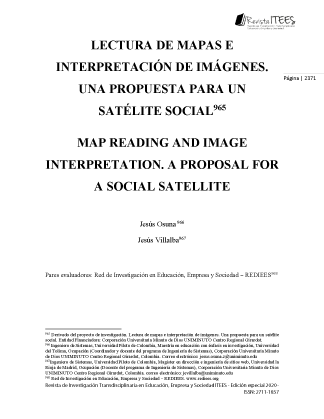CXXV. MAP READING AND IMAGE INTERPRETATION. A PROPOSAL FOR A SOCIAL SATELLITE
##plugins.themes.bootstrap3.article.main##
Abstract
This article aims to cover the meaning of the reading of satellite maps and the interpretation
of the images that are reproduced and that are sent by nature, for our country. This, bearing
in mind that in today's world it is a subject that has been little studied, but that certainly has
great relevance; to the extent that it is impossible to imagine a scenario where we do not have
a GPS that allows us to locate ourselves in space, where there is no sample of these satellite
maps and a WIFI network that facilitates communication with people who are in the other
side of the world, a function that is performed by satellites; hence the importance of this
article. In the same way, it is a text that responds objectively to want to show, how through
the proposal of a social satellite, it is possible to find solutions within the same society, and
to prevent in this way endless situations related to the security, climate change, the
prolongation or prevention of possible catastrophes and many other scenarios that can only
be obtained from the help generated by satellites. This article responds to a purely
documentary research methodological process, insofar as it is intended to equate its
intentionality with the work that has been carried out in other settings where the results
always end up being timely for the people immersed in the research.
Download Statistics
##plugins.themes.bootstrap3.article.details##
social satellite, map reading, documentary research, GPS
Bosque, Gente y Educación Ambiental. FICH-UNL. Santa Fe. 2005
Cartografía Digital (15 de agosto de 2020) Mapas vectoriales [Mensaje en un blog].
Cartografía Digital. Recuperado de:
https://www.cartografiadigital.es/2013/10/mapas-vectoriales.html
Cisnero, C. M. A. G. El empleo de imágenes satelitales en la elaboración de nuevas obras
cartográficas con destino al turismo. The use of satellite images in the development
of new cartographic works destined to tourism.
Gómez, L. (2010). Un espacio para la investigación documental. Revista Vanguardia
Psicológica Clínica Teórica y Práctica, 1(2), 226-233.
Gurumendi Alvarado, R. P. (2020). Diseño e implementación de dispositivo de rastreo
satelital inteligente GPS mediante microcontrolador programable con activación de
apagado automático mediante zonas poligonales en GOOGLE MAPS (Doctoral
dissertation, Universidad de Guayaquil. Facultad de Ciencias Matemáticas y Físicas.
Carrera de Ingeniería en Networking y Telecomunicaciones).
Gutiérrez, O. D., & Cisnero, M. A. G. (2017). El empleo de imágenes satelitales en la
elaboración de nuevas obras cartográficas con destino al turismo. UD y la geomática,
(12), 47-54.
Morales, O. (2003). Fundamentos de la investigación documental y la monografía. Manual
para la elaboración y presentación de la monografía. Mérida, Venezuela: Universidad
de Los Andes.
Red Hat (20 agosto de 2020) ¿Qué es el open source? [Mensaje en un blog]. Red Hat.
Recuperado de: https://www.redhat.com/es/topics/open-source/what-is-open-source
Rodríguez-Morales, A. J. (2008). Impacto potencial para la salud pública latinoamericana
del lanzamiento y puesta en órbita del satélite VENESAT-1. Revista Peruana de
Medicina Experimental y Salud Pública, 25(4), 444-444.
Teniente de Navío, C. G. (2007). Extracción de mapas temáticos a partir de la clasificación
en imágenes satelitales (Doctoral dissertation, Instituto Nacional de Astrofísica,
Óptica y Electrónica).





